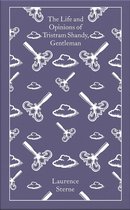W2 Lecture notes
Slides Notes: MARX AND STERNE
1 Case studies putting the writers in dialogue
Title exploring their relationship with lit and phil. Sterne
as a philosophical writer and Marx as a literary one
2
Lecture Outline
3 Publishing in 9 vols between this time
Laurence 1st person auto biographical
Sterne, Long digressive sentences
Tristram Playful, witty tone, conversational
shandy (1759 - This is typical of his writing
67) The plot isn't apparent, in trad with learned wit.
Tristam starts unusually with his conception
All talk of humours and dispositions, makes playful
use of early scientific theory about human nature.
4 How can a literary writer make use of philosophy in
Sterne and their work?
Philosophy "the minutest philosophers"(vol1, ch.2) ... "my
(TS, vol.1, ch1- father who was an excellent natural
5) philosopher"(vol1, ch.3). Mentions of the term but
with different meaning to the ones we have now,
philosophy and science then being interchangeable
words.
“we need to recognise the different meanings of the
term philosophy available to [Sterne] and his
readers in the eighteenth century. It encompassed
natural and practical philosophy, reasoning and
knowledge as well as ethics and metaphysics.
Furthermore, the forms in which philosophy is now
written academic papers and monographs are less
various than in previous ages when poems,
dialogues and fables might be the vehicles for
philosophical debate and instruction.”
Judith Hawley, “Tristram Shandy, Philosopher”, Textual
Practice 31, no. 2 (2017): 243.
• Tully [Cicero], Puffendorff [Samuel von Pufendorf ],
Montaigne, “the sagacious Locke." - tristam does mention
different philosophy.
• his mother getting aroused by the winding of the clock
“an unhappy association of ideas which have no connection
in nature”( 1, ch. 4).
5 Ideas are generated through sense impressions and
, John Locke, An repeated habits.
essay Sterne's use of Locke is direct reference. A parody?
concerning
human
understanding
(1690)
6 Briggs, Peter M. “Locke’s Essay and the
Bibliography on Tentativeness of Tristram Shandy ”. Studies in
Sterne, Locke Philology 82, no. 4 (Autumn 1985): 493 520.
and Philosophy Davies, Paul, ed. “Laurence Sterne and Philosophy”.
Textual Practice 31, no. 2 (2017).
Hawley, Judith. “Tristram Shandy, Philosopher”.
Textual Practice 31, no. 2 (2017): 233 46.
Maskell, Duke. “Locke and Sterne, or Can Philosophy
Influence Literature?” Essays in Criticism 23, no. 1
(January 1973): 22 40.
Moglen, Helene. The Philosophical Irony of Laurence
Sterne . Gainesville: University Presses of Florida,
1975.
Swearingen, James E. Reflexivity in “Tristram
Shandy”: An Essay in Phenomenological Criticism .
New Haven: Yale University Press, 1977.
Traugott, John. Tristram Shandy’s World: Sterne’s
Philosophical Rhetoric . Berkeley: University of
California Press, 1954.
Tuveson, Ernest Lee. “Locke and Sterne”, in Reason
and the Imagination: Studies in the History of Ideas,
1600 1800 , edited by Joseph Anthony Mazzeo , 255
77. New York: Columbia University Press, 1962.
7 Nearly all modern commentators on Tristram Shandy have agreed
Briggs on that Lockean ideas of human understanding figure importantly in
Sterne and the development of Sterne’s novel. But they have differed
Locke considerably from one another in their attempts to assess the spirit
in which Sterne wished to use Locke. Was Sterne engaged in a
fictional translation and exposition of Lockean ideas? Or was he
subverting Locke, using Locke as a straight man in the midst of a
Shandean comedy? Or is Sterne better understood simply as an
artistic opportunist, capitalizing upon the public currency of
Lockean ideas about the mind’s various workings? And why invoke
a philosopher in the first place? Most novelists do not appear to
need philosophical assistance to complete their labors.
Briggs, Peter M. “Locke’s Essay and the Tentativeness of Tristram
Shandy ”. Studies in Philology 82, no. 4 (Autumn 1985): 493.
There is a discussion on deciding on the use of Locke's ideas





